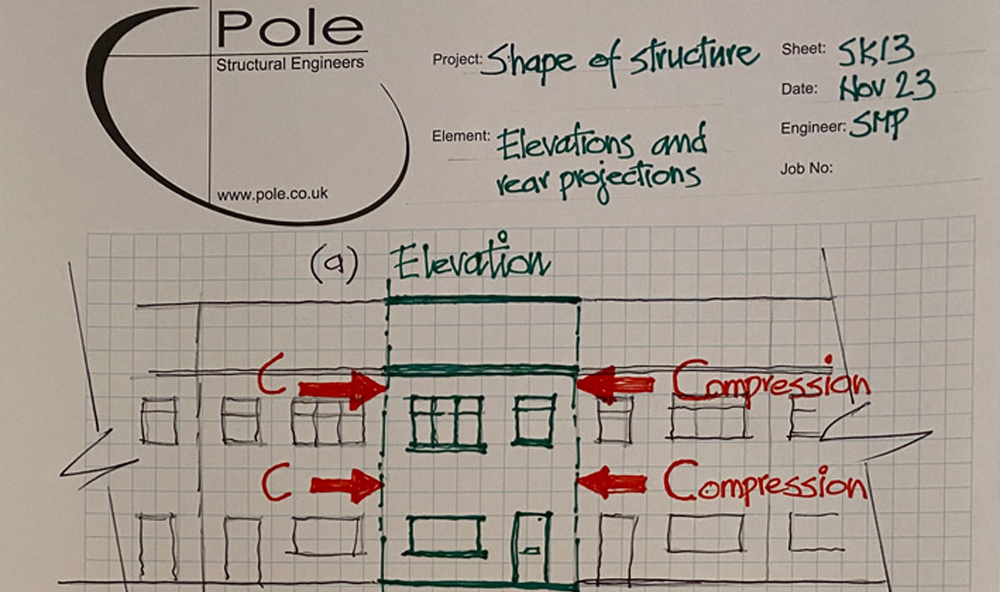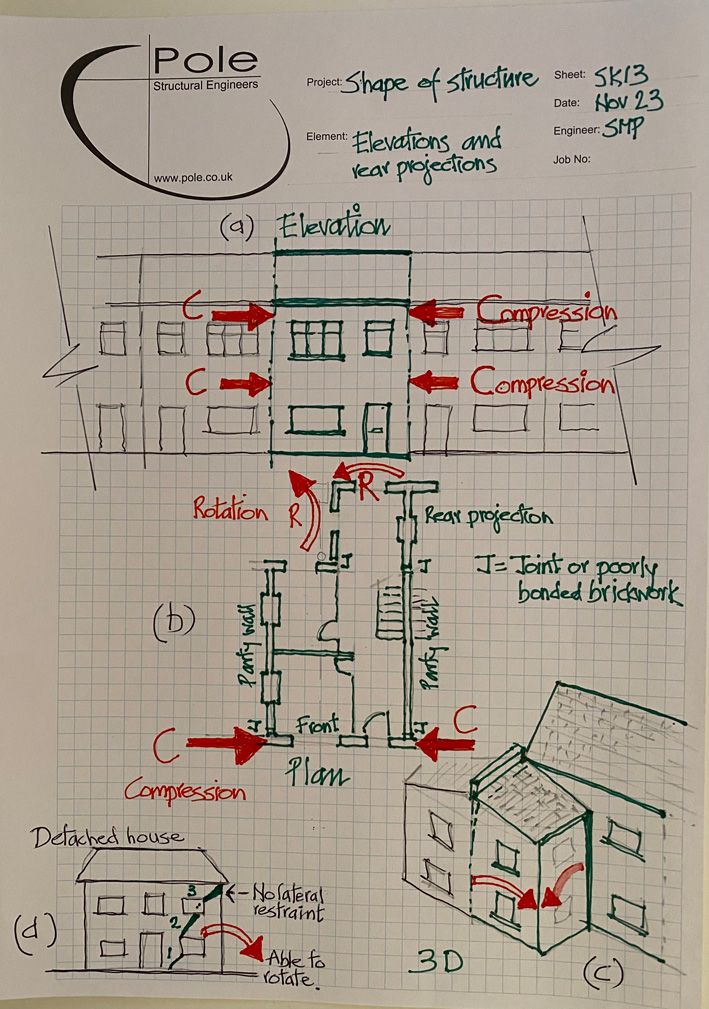The question posed
Why do we all find much more movement and cracking specifically within the rear addition/projection compared to the front elevation, when considering mid terraced Victorian houses in London.
Any discrepancy between the amount of trees to front and rear can be ignored. Bay window projections are also excluded for discussion purposes.
The answer
The answer, prior to the explanation, is simply due to the relative lack of lateral restraint or buttressing of a rear addition compared to the continuous nature of the front elevation.
The explanation
To be read with the sketch Sk13 (a to d) below.
Diagram (a) shows a front elevation of four houses with the subject house coloured green.
Diagram (b) shows its plan form with continuity of the front elevation, with rear projection adjoining its neighbour to the right. The letter “J” denotes a joint between abutting walls, often where the party walls abut the front elevation, where the flank wall abuts the main rear wall and also often within the party wall where there is sometimes a joint or gap (Used for the old lead pipes for the water tank) but more commonly poor bonding of brickwork.
Diagram (c) shows a simple isometric demonstrating how the rear projection is free to tilt away from the main house and to a lesser extent away from its neighbour.
Diagram (d) replicates the previous question 1 for ease of reference where we explored the subsidence to the right hand side of the frontage with tapered diagonal cracks emanating from the free edge at the top flank corner and gradually propagating downwards to the pivot point near the front door.
Overview
If we step back from our detailed site surveys and Structural Engineers reports for a moment we can consider the structural “form” of different building types whether they are framed steel or concrete office blocks or, in this instance, very simple plain brickwork housing stock.
In their purest forms, houses are a series of boxes.When a terrace is formed, with one long elevation at the front and a number of rear projections at the back, we have a number of boxes but connected together to become stronger, at least as far as the front and main rear elevation are concerned.
The rear projections are normally pairs of boxes twinned with the neighbour in respect of its rear wall but remain a single box structure with regard to the flank wall.
Unfortunately, whilst a box structure is normally strong when the corners are rigidly connected, many Victorian houses have gaps or joints between abutting walls, and in particular with regards to the rear projections. This is because they were invariably built by different teams of people, a number of weeks after the main house was built and with little regard, in many instances, to connecting the two structures together.
Whereas, the front elevation of a mid terraced house is sandwiched in between other houses and forms part of a much longer and continuous wall structure, a rear projection. As the name infers it is a “projection” from the general building line and, therefore, lacks any lateral support by comparison.
The enclosed diagram indicates the compressive or lateral restraint of this elevation if it tries to tilt within its vertical plane as per the detached or end of terrace house, as explained in a previous article.
The plan diagram (b) and simple isometric diagram (c) shows how the flank wall of the rear projection and the rear wall, to a lesser extent, is free to rotate when subsidence of the ground occurs. NB subsidence magnitude is not uniform and occurs greatest nearer a tree.
In Quiz question 1 we explored how unrestrained walls, such as those of a detached or an end of terrace, tend to tilt and rotate as a consequence of foundation movement. See diagram (d) on SK13. The rear projection flank walls behave in the same way, as do bay window projections.
There are multiple reasons why a rear projection might subside, many mentioned in the various comments thank you. It is the shape and form which allows the rear addition to move, assuming all other factors are broadly equal.
By way of general observations the most common causes of rear addition subsidence (Modern day movement), compared to the front elevation, tend to be;
- Located nearest mature and or more frequent trees and large shrubs.
- Drainage passes parallel and often below flank wall footings.
- Lack of bonding or tying-in to main rear wall or house party wall.
- Shallower foundations than the main house, particularly when the cellar is under the hallway and stairs.
Other common defects found within rear projections but which do not particularly contribute to the foundation movement discussion include;
- Poor brickwork quality generally, compared with frontage
- Poor bonding with the use of snapped headers.
- Built in timbers including backing lintels to brick arches
- Lack of lateral restraint perpendicular to floor span.
- Overloading of first floor joists from heady partition loads and roof props.
- Mono pitched roofs often undersized. Often no loft access to assess.
Watch this space and on Linkedin for further quiz questions and discussions.





